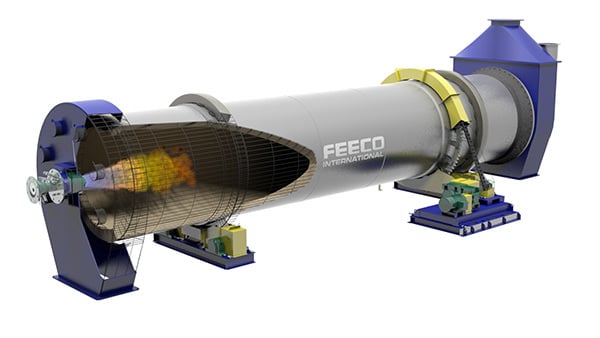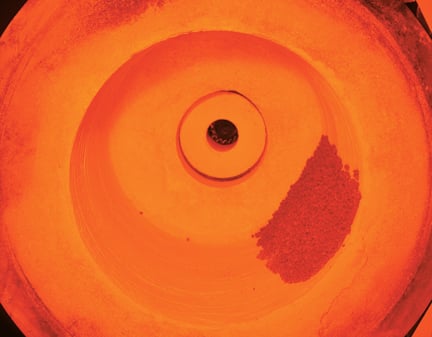Rotary kilns are widely used across industries that require precise, high-temperature heating of materials, such as mineral processing, chemical production, and waste management.
Understanding the differences between direct and indirect-fired designs is critical for engineers seeking the right equipment for specific thermal processing requirements; while both kiln types can achieve similar goals, their operational mechanisms, efficiency, and applications differ significantly.
Direct-Fired Rotary Kilns: High-Efficiency, Cost-Effective Heating
In a direct-fired rotary kiln, fuel is burned directly within the drum, with the combustion gases coming into direct contact with the material being processed. This method allows for efficient heat transfer, making it ideal for processing large quantities of material at high temperatures. The direct contact between combustion gases and material accelerates the heating process, especially when dealing with materials that require substantial heat input to achieve the desired product.

3D Rendering of a Direct-Fired Kiln
Key Features of Direct-Fired Rotary Kilns:
- Fuel Combustion:
- The fuel (such as natural gas, propane, or fuel oil) is introduced into the rotary kiln and burned within the drum. The resulting combustion gases flow through the drum, directly contacting the material being processed.
- The heat from the combustion gases is transferred efficiently to the material, raising its temperature rapidly. This process is suitable for materials that can tolerate exposure to these gases without negative effects.
- A refractory layer is employed to protect the carbon steel drum shell from the high temperatures within.
- Heat Transfer Efficiency:
- The direct contact between combustion gases and material ensures a high heat transfer rate, making direct-fired kilns particularly efficient for applications requiring substantial thermal input in a short amount of time.
- The material is heated more quickly compared to indirect systems, which can be a significant advantage in large-scale operations where throughput is critical.
- Combustion gases may flow congruently (co-current/parallel) or in opposition (counter-current) to the material flow. Co-current flow is best for materials requiring a rapid initial temperature change, while a counter-current flow allows for a more gradual change and is more thermally efficient.
- Cost-Effectiveness:
- Due to its simpler design and direct heating method, direct-fired rotary kilns are often more cost-effective than their indirect counterparts.
- The need for fewer components lowers both initial capital costs and ongoing operational expenses, making it a more cost-effective option for many applications.
- Applications:
- Industries processing materials that can withstand exposure to combustion gases, such as mineral processing, roofing granule production, and metal recycling, use direct-fired rotary kilns.
Considerations for Direct-Fired Rotary Kilns:
- Temperature Control:
- While the direct heating method provides efficient thermal transfer, precise temperature control can be more challenging. Fluctuations in the combustion process, such as variations in fuel composition or air supply, can lead to temperature inconsistencies within the drum. This may be an issue when consistent processing conditions are critical to the product quality.
- While the direct heating method provides efficient thermal transfer, precise temperature control can be more challenging. Fluctuations in the combustion process, such as variations in fuel composition or air supply, can lead to temperature inconsistencies within the drum. This may be an issue when consistent processing conditions are critical to the product quality.
- Exhaust Gas Handling:
- A direct-fired kiln’s exhaust system must handle the combustion gases, which can contain pollutants like ash, soot, gaseous emissions, and volatile compounds. To comply with environmental regulations, a robust air pollution control system is required to filter and treat these gases before they are released into the atmosphere.
Indirect-Fired Rotary Kilns: Precision and Contamination-Free Processing
In contrast, an indirect-fired rotary kiln burns fuel outside the rotary drum, and the heat is transferred to the material indirectly through the drum’s walls. The absence of direct contact between the combustion gases and the material being processed provides greater control over the thermal environment inside the kiln, making it an excellent choice for materials that are sensitive to contaminants or require precise temperature control.

3D Rendering of a FEECO Indirect-Fired Kiln
Key Features of Indirect-Fired Rotary Kilns:
- Precise Temperature Control:
- Since the combustion gases are not in direct contact with the material, indirect-fired kilns allow for much greater control over the internal temperature.
- Temperature variations within the drum are minimized, which is particularly important for applications requiring high product quality or where strict temperature profiles are necessary to achieve specific chemical reactions or material properties.
- Since the combustion gases are not in direct contact with the material, indirect-fired kilns allow for much greater control over the internal temperature.
- Ideal for Sensitive Materials:
- Indirect-fired kilns are essential for processing materials that cannot tolerate exposure to combustion gases. This includes fine chemicals and catalysts, where contamination from gases, ash, or dust is undesirable. They are also utilized in pyrolysis applications for generating syn-gas that can be used as an alternative fuel or converted into an actual product.
- The design also prevents fine materials from being swept away with the exhaust gases – the lack of airflow within the drum prevents material from becoming entrained and carried out to the exhaust gas system.
- Indirect-fired kilns are essential for processing materials that cannot tolerate exposure to combustion gases. This includes fine chemicals and catalysts, where contamination from gases, ash, or dust is undesirable. They are also utilized in pyrolysis applications for generating syn-gas that can be used as an alternative fuel or converted into an actual product.
- Applications:
- Industries such as catalyst production, specialty chemicals, and waste management/recycling often rely on indirect-fired rotary kilns to ensure that the materials are not contaminated during thermal processing.
- These kilns are useful for applications involving delicate or finely powdered materials that require a controlled atmosphere without the risk of becoming entrained in the exhaust flow.
Considerations for Indirect-Fired Rotary Kilns:
- Lower Heat Transfer Efficiency:
- The key tradeoff in indirect-fired rotary kilns is that heat is transferred indirectly through the shell of the kiln, rather than through direct exposure to combustion gases. This results in a lower heat transfer efficiency, meaning it typically takes longer and requires more energy to heat the material to the desired temperature compared to direct-fired systems.
- The key tradeoff in indirect-fired rotary kilns is that heat is transferred indirectly through the shell of the kiln, rather than through direct exposure to combustion gases. This results in a lower heat transfer efficiency, meaning it typically takes longer and requires more energy to heat the material to the desired temperature compared to direct-fired systems.
- Higher Operational Costs:
- The complexity of indirect-fired kilns, including the need for external heating systems and a shell constructed of more temperature-resistant material, can drive up both the initial cost and ongoing maintenance expenses.
- This design is generally more expensive to install and operate, but the aforementioned benefits associated with specific applications, often outweigh the added costs.
Key Differences Between Direct and Indirect-Fired Rotary Kilns
| Feature | Direct-Fired Kiln | Indirect-Fired Kiln |
| Heat Transfer | Direct contact with combustion gases for efficient heat transfer. | Heat is transferred indirectly through the kiln shell, reducing efficiency. |
| Applications | Suitable for materials that can tolerate combustion gases (e.g., roofing granules, aluminum scrap). | Ideal for sensitive materials requiring contamination-free processing (e.g., catalysts). |
| Temperature Control | Less precise due to variations in combustion gases. | More precise control due to the separation of combustion gases from the material. |
| Efficiency | More energy-efficient because of direct heat transfer. | Less energy-efficient due to indirect heat transfer. |
| Cost | Generally more cost-effective due to simpler design. | Higher initial and operational costs due to additional components. |
Choosing the Right Rotary Kiln for Your Process
Both direct- and indirect-fired rotary kilns play pivotal roles in thermal processing across various industries. When the material can withstand exposure to combustion gases, direct-fired kilns are preferred in applications where high heat transfer efficiency and cost-effectiveness are critical. These kilns are often chosen for large-scale, high-temperature applications like mineral processing.
In contrast, indirect-fired rotary kilns are indispensable for applications requiring precise temperature control and where contamination must be avoided. Industries such as catalyst production and fine chemicals rely on the advantages of indirect-fired kilns to meet strict quality standards and ensure product integrity.
For engineers, selecting the right kiln design requires careful consideration of factors such as the material being processed, the temperature requirements, the need for contamination control, and the overall efficiency of the system. The right choice will not only improve the efficiency and quality of the process but also help to optimize operational costs and meet regulatory standards.
Ultimately, both kiln types offer distinct benefits. Understanding the strengths and limitations of each will enable engineers to make informed decisions that enhance both the efficiency and quality of their thermal processing operations.
FEECO is the leading provider of custom direct- and indirect-fired rotary kilns. With batch- and pilot-scale testing available, plus comprehensive parts and service support, FEECO ensures that each kiln is tailored to meet the unique needs of your thermal processing application, backed by decades of expertise and a commitment to innovation in material processing.
For more information on rotary kilns, contact us today!
Looking for answers on rotary kilns? Check out our FAQs!

